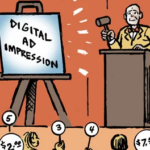 “The Sell Sider” is a column written by the sell side of the digital media community.
“The Sell Sider” is a column written by the sell side of the digital media community.
Today’s column is written by Frost Prioleau, CEO and co-founder of Simpli.fi.
One of programmatic’s biggest benefits has been the liquidity it offered in the marketplace for display advertising impressions.
Before programmatic and real-time bidding (RTB), in particular, the market for display advertising was much more fragmented. Buyers needed to shop multiple publishers and networks to reach their targeted market at scale, while publishers needed to maintain expensive sales organizations to sell inventory to multiple buyers in an inefficient market.
For advertisers and buyers, the increased liquidity created by RTB meant that by using a demand-side platform that tapped into multiple exchanges, the buyer could access unprecedented pools of inventory and bid only one inventory that best met the needs of their campaigns.
While buyers loved RTB for its increased performance, many publishers soon soured on RTB, branding it “race to the bottom” because of the low prices paid for their inventory.
The Race To The Bottom
A common refrain: The unlimited supply of inventory drove down prices. But this was only partly true. There was never an unlimited supply of legitimate inventory, rather just an unlimited supply of non-human inventory. A wave of bot-driven inventory drove prices down as buyers failed to differentiate between human and non-human traffic.
Many quality publishers exacerbated the race-to-the-bottom pricing by not including their name on the inventory sold on the open market for fear that it would hurt direct sales efforts. Making their inventory “anonymous” and not sharing information with bidders about where ads were to be shown further drove down prices for some quality inventory. A recent study showed that members received a CPM of $2.27 on “semi-transparent” inventory vs. a CPM of only $0.49 on anonymous inventory where the site wasn’t specified.
Another reason for low RTB inventory prices: Some quality publishers flooded their pages with ads, further driving up supply. For example, when Facebook Exchange first launched, the ads were small and often numbered a dozen or more per page. The result was ads that sold for very little and performed poorly, when measured by click-through rates and click-only attribution. Once Facebook reduced the number of ads per page and also increased the size of ads, performance, CPMs and overall revenue increased.
Leaving Open Auctions
Partly because of the race-to-the-bottom environment, many publishers decided that the open auction was not right for them because they were not receiving high enough CPMs for their impressions.
But is the move to closed, private auctions or programmatic direct really the way to go? Private auctions can eliminate liquidity, make discovery more complicated and add sales and administrative costs to selling inventory.
Instead of moving to closed private auctions, I believe buyers and sellers should try to fix the open marketplace in order to deliver the CPMs to publishers that they need to bring their best inventory to the open market.
One suggestion would be for buyers to pay only for human-viewed inventory. This is easier said than done, but the industry is focused on this and is making progress. Reallocating budgets from bot traffic to human-viewed traffic will drive prices up for the limited inventory of the latter. We are already seeing progress as many sellers of quality inventory have reported 100% increases in CPMs over the last year.
Another suggestion: Increase transparency. Buyers are willing to pay for ad space on known sites. Sellers can increase CPMs by moving toward transparency.
The industry also needs to leverage publisher data more effectively. While many publishers still do not leverage their own data, others are now working with various platforms to do so and finding that adding data to impressions lifts prices. For example, even though an impression may be on a low-value page, the user may have just done an on-site search for a car type or a travel destination, which makes the impression much more valuable to buyers.
Finally, we must use floors more intelligently. Buyers are willing to pay up for inventory that works. There are many cases where sellers could more effectively use floors to increase their overall revenue from open auctions.
The open auction marketplace brings massive liquidity, eliminates inefficiencies associated with discovery and reduces selling and administrative costs. Instead of abandoning it, there are ways to get publishers the value for their inventory that will motivate them to bring their best inventory to open auctions.
Follow Frost Prioleau (@phrossed), Simpli.fi (@Simpli_fi) and AdExchanger (@adexchanger) on Twitter.













